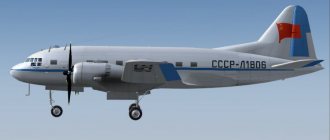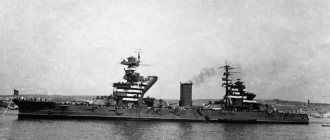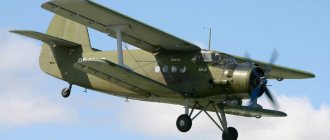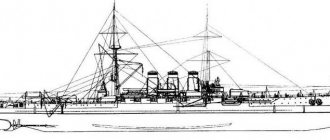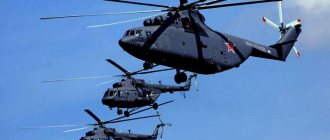Interesting Facts
Perhaps the most famous modification of the IL-76 family is the IL-76TD. The plane was intercepted over Afghanistan by a Taliban fighter and was forced to land. The pilots were captured and held hostage for more than a year.
The plane was of a certain value to terrorists, so pilots were periodically brought in to maintain the aircraft. While performing this work, the crew managed to lift the car into the air and reach the United Arab Emirates at an ultra-low altitude.
For this feat, the crew commander and first pilot were awarded the title of Hero of Russia. The remaining pilots were awarded Orders of Courage.
Design Features
Let's consider the main design elements of the IL-76 and the basic parameters of the transport aircraft.
Fuselage and wing geometry
The equipment was built in accordance with the classical aerodynamic design of transport aircraft. This is a rounded fuselage, which is conventionally divided into four independent compartments:
- Adjacent cockpits;
- Isolated navigator's cabin;
- Gunner's cabin;
- Transport compartment.
The aft part of the fuselage is equipped with a three-leaf hatch: the side pillars go to the sides, the central one goes up. After opening the hatch, a ramp is formed, intended for landing military units and armored vehicles. The transport compartment is equipped from the inside with a monorail, roller tables and hoists.
Based on the location of the wing, the IL-76 belongs to the high-wing category. The planes are swept-back, equipped with an advanced mechanization system, providing the ability to take off and land with the maximum payload. Each wing is equipped with three-section ailerons and brake flaps.
The keel tail is T-shaped. In general, the keel of this aircraft has an innovative solution. This is a ladder ladder that simplifies the inspection and repair of the steering. The design was called “Novozhilov Avenue”, and is quite successfully used on other types of transport aircraft of military and civil aviation.
Chassis
The aircraft's undercarriage is implemented in the form of a 5-support landing gear: one strut is located in the forward part of the fuselage, the other four serve as the main supports. The internal tire pressure is adjustable and is adjusted depending on the surface of the runway: soil or concrete. The chassis is retracted using a hydraulic system. When folded, the main supports are located at an angle of 90 degrees relative to each other.
Fuel supply system
The layout of this unit ensures the following functions:
- Pumps fuel to the main power units;
- Provides power to auxiliary power units.
The system includes caisson tanks located in the wing planes. With centralized refueling, the aircraft can take on board 109,480 liters of fuel. Inside the tanks there is a programmable fuel supply control system. The system provides plugs for draining condensate and fuel.
Automatic Piloting System
This task is performed by the SAU-1T-2B module. The software solves the following problems:
- Autopiloting along a planned route with altitude climbing to the maximum value;
- Performing pre-landing maneuvers;
- Approach;
- Landing;
- Speed and altitude stabilization.
Dimensions of IL-76
Fire extinguishing and neutral gas systems
The fire protection system performs three main functions:
- Detects the source of fire;
- Signals the crew about this;
- Takes measures to extinguish the fire.
This module controls the main engine nacelles, auxiliary power unit compartments, and the front center section. The Il-76 fire protection system uses freon 114 B2 to fight fire. The fire extinguishing component is placed in three cylindrical cylinders. If the aircraft makes an emergency landing (landing gear retracted), the fire protection system automatically discharges the onboard fire extinguishers.
The fire extinguishing system is controlled from the control panel. The module is supplemented with a monitoring device, which is triggered when the engine guns overheat, or the fuel supply lines are destroyed or depressurized.
In addition, a neutral gas system is installed on board the IL-76. The principle of operation is that neutral gas is injected into the above-fuel space of fuel tanks. This element ensures the safety of fuel tanks in case of fire or damage to the surfaces.
Weapon systems
Considering that we are talking about a military transporter, the aircraft is equipped with protective equipment. In particular, a 9A-503 defensive complex is installed on board, consisting of the following elements:
- Two double-barreled aircraft guns of the GSh-23 class;
- Active interference generator “Lilac”;
- Automatic reset machines;
- Machines for setting passive jamming;
- Infrared countermeasures;
- Suspension for 500 kg free-fall bombs.
Fire control is carried out from the control panel located in the gunner-pilot's cockpit.
Hydraulic system
Hydraulics ensure the functionality of the following aircraft elements:
- Retracting / releasing the landing gear;
- Chassis braking and control;
- Flaps and slats;
- Brake flaps and spoilers;
- Control of entrance doors and hatches;
- Ramp and tail control;
- Control of the photo sunroof and windshield wipers.
The hydraulics are divided into two independent lines.
Energy supply
Power supply for on-board systems is provided by four alternating current generators. The overall system is divided into two independent subsystems on the port and starboard sides. It is noteworthy that subsystems can operate in individual or parallel modes. At the same time, only 3 channels of electric generators out of four can be combined into a parallel system.
Additionally, the aircraft is equipped with a backup power system, which is activated when the main power generators fail. The backup power supply is provided by a synchronous three-phase non-contact generator.
Lighting equipment
Internal lighting of working modules and compartments is provided by white and red lamps installed in the tail section, transport compartment and pilot cabins. In addition, four emergency exit signs are installed inside the aircraft.
External lighting is represented by navigation lights and landing and taxi lights.
Instrumentation
Air navigation tasks are performed by the following systems:
- Pressure switch measuring complex;
- Total and static pressure;
- Altitude and speed signals;
- Correctors-setters.
In addition, the instrumentation includes aircraft attitude systems. This function is performed by:
- Power failure alarm;
- Gyroscopic vertical;
- Pitch and roll indicators;
- Attitude horizon;
- Electric direction indicators;
- Magnetic compass.
IL-76 – cockpit
Oxygen supply
This system is responsible for the life support of the crew at high and low altitudes in a closed and depressurized cabin. In addition, clean air in cylinders helps with smoke in the cabin or in situations where the plane flies over contaminated areas.
Navigation Aids
This module is presented by the TKS-P course system. This device determines the course and indication of the aircraft, and the data is transmitted to other on-board systems. The operating principle of this system is based on the calculation of linear accelerations.
BSOC
This is an on-board system that records on magnetic tape all flight parameters, the functionality of power units and navigation systems. In addition, the unit includes a voice recorder that records recordings of conversations between crew members.
Radio equipment
It is divided into several related subsystems:
- Forward looking radar;
- Intercoms and loudspeakers;
- Radio station operating on short waves;
- Telecode communication devices;
- Radio compass;
- Dosimeters;
- Radio systems for short- and long-range navigation;
- Aircraft radar transponders;
- Altimeter;
- Drift angle and speed meter;
- Radiation warning system;
- A computing complex built on the basis of the on-board computer “Gnome-A”;
- Dome class sighting system.
Fate
Like a person, an airplane has its own destiny. Here are just two examples. In the aviation museum in Monino there is an Il-76 USSR-86047, and few people wonder how it got there. And the fate of this “tenacious” aircraft is quite interesting.
In September 1979, this aircraft arrived in Panevezys, and a week later it was transported to Tartu. A month later, during night flights, its landing gear was retracted before lifting off the runway. Sparks rained down in all directions... On landing, one tire burst, and the remaining 15 were cut down to the last cord, but did not burst.
Rare photo. The famous “indestructible” Il-76 parked in Monino
Soon 86047 ended up in Kėdainiai, and then in Panevezys. On March 14, 1985, it landed without landing gear (they simply forgot to release them). The plane was lifted on pneumatic fabric lifts, gradually laying supports from sleepers under the planes, the pneumatics and landing gear doors were replaced, the cabin was patched up and it was driven to Tashkent. They ferried it without retracting the landing gear, with several intermediate landings. After repairs, the board returned to Panevezys.
In one of the flights (August 1987), during a go-around, the crew commander did not give the required commands to increase the engine speed to take-off, the senior on-board technician increased it according to his understanding to the nominal value and removed the mechanization. As a result, the plane dropped from 200 m to 15 m and began to catch trees. The crew increased engine operation and were able to gain altitude. After landing, as eyewitnesses recall, “we pulled out a lot of tree branches from the engines and gaps in the places where the ailerons were mounted.” The landing gear doors were also heavily damaged.
Il-76 TD at Machulishchi airfield, near Minsk
The plane was repaired in Kėdainiai, but, according to rumors, the BTA commander said something like: “We won’t wait for a third time” and ordered the plane to be transported to Monino. But even here, during landing, the plane almost rolled off the runway. There he finally found peace...
The fate of the Il-76 USSR-78821 is the direct opposite of the “survivable” 86047. After arriving at the aviation regiment, the aircraft received damage to the nose. The evening before the incident, the plane was delivered by a TZ-22 tanker. In order for it to land not on the ground (it was wet), but on concrete, the plane was rolled out of the parking lot towards the MRD a little. The TK was successfully unloaded, but then it turned out that the civilian driver of the tractor had finished his work day and had driven it to the park. They decided to completely park the plane later in the morning. But late at night, one of the regiment’s aircraft returned from a business trip, which, while taxiing, smashed the nose of 78221 with the tip of its wing. And the aircraft was practically new (about 400 hours of flight time).
After the incident, 78821 was parked for almost 10 years, being a “donor” for other Il-76s, until it was transferred to one of the airlines. But even here the plane flew for less than a year: on April 18, 2001, during takeoff from the Ostend airfield (Belgium), an engine malfunction alarm sounded on the plane. The crew commander made a decision: to stop the takeoff and taxi along the high-speed taxiway. While entering it, the plane came off the concrete, broke one of the struts and “loaded” in the ground. They did not restore it, and it was soon dismantled. Fate…
My skydiving D-5
I jumped with a D-5 parachute, and I can share my impressions... These are the most exciting jumps of my life...! I have 5 of them... As many as 5...!!! After the first three jumps on the D-1-8 series 6 they gave the D-5 parachute and said that 5 jumps were required. If I do, they will give me another parachute, better... To be honest, I suffered a lot of fear with it. After the first jump with the D-5 parachute, having laid it down, I hid on the launch pad under the trailer with parachutes... so as not to be seen by the instructor, and so that he would not drive me into Heaven. This went on for five painful days. I’ll make a jump, put a parachute... and under the trailer... another girl was hiding there... and the two of us sat under the trailer until the end of the jumping day... :))
The D-5 parachute jump is performed from a height of 800-1000 meters. The minimum drop height is 600 meters. From exiting the plane to the opening of the parachute, 200 meters. So just consider... you left 800 - at 600 you will be hanging in the air under the dome...
So... Jump...! You get out of the plane in the air... and suddenly something grabs you by the collar and flutters across the Sky... and you count 121, 122, 123, 124, 125 (we had such a count, I still count numbers for 5-10 seconds)... you pull the ring... and this “something” just takes you and throws you... and it feels like you have been completely abandoned... in Heaven... abandoned... and a feeling of helplessness... how is this...? abandoned...! and suddenly... the dome is filled... big, white, round and beautiful... and such a happy exhalation...! and I want to scream and sing songs... and I screamed... AAAAAAA...!!!! at the top of your heart...! with joy... :)) there, in the air, you can scream as much as you want... and after landing for a few seconds I lay and looked at the sky... blue... high... clouds floating... silence around... the smell of meadow grass... the grasshopper chirps... so good... everything is behind... I would have been lying in the grass in those moments, but you can’t scare the instructors... you need to stand up and indicate that everything is in order... otherwise they will send a car... a nurse...
This is how they jump, with a D-5 parachute... with a surprise in the air... The D-6 parachute is a slightly modified version of the D-5 parachute.
In the D-6, the riser ends are not fixed to the backpack, they can be pulled... they call it a roll of the risers... where we reduce the risers, the canopy goes in that direction... It can give out a horizontal speed of 3-4 meters per second... and there are control lines for turning the dome... slowly... but unfolding...
We study the equipment of parachutes D-5 and D-6
Characteristics of the D-5 parachute
Characteristics of the D-6 parachute
I give information about new landing parachutes
The D-10 landing parachute is a parachute landing system that replaced the D-6 parachute. The dome area is 100 sq.m. with improved characteristics and beautiful appearance - in the shape of a squash.
New! The landing parachute D-12 Listik is a super parachute system. A unique system, there are no analogues in the world. I liked it very much... :)) New equipment, increased flight weight at a low descent speed.
Intelligence has its own wings! For them, the special-purpose parachute Arbalet-2. This is another unique system that has no analogues in the World.

